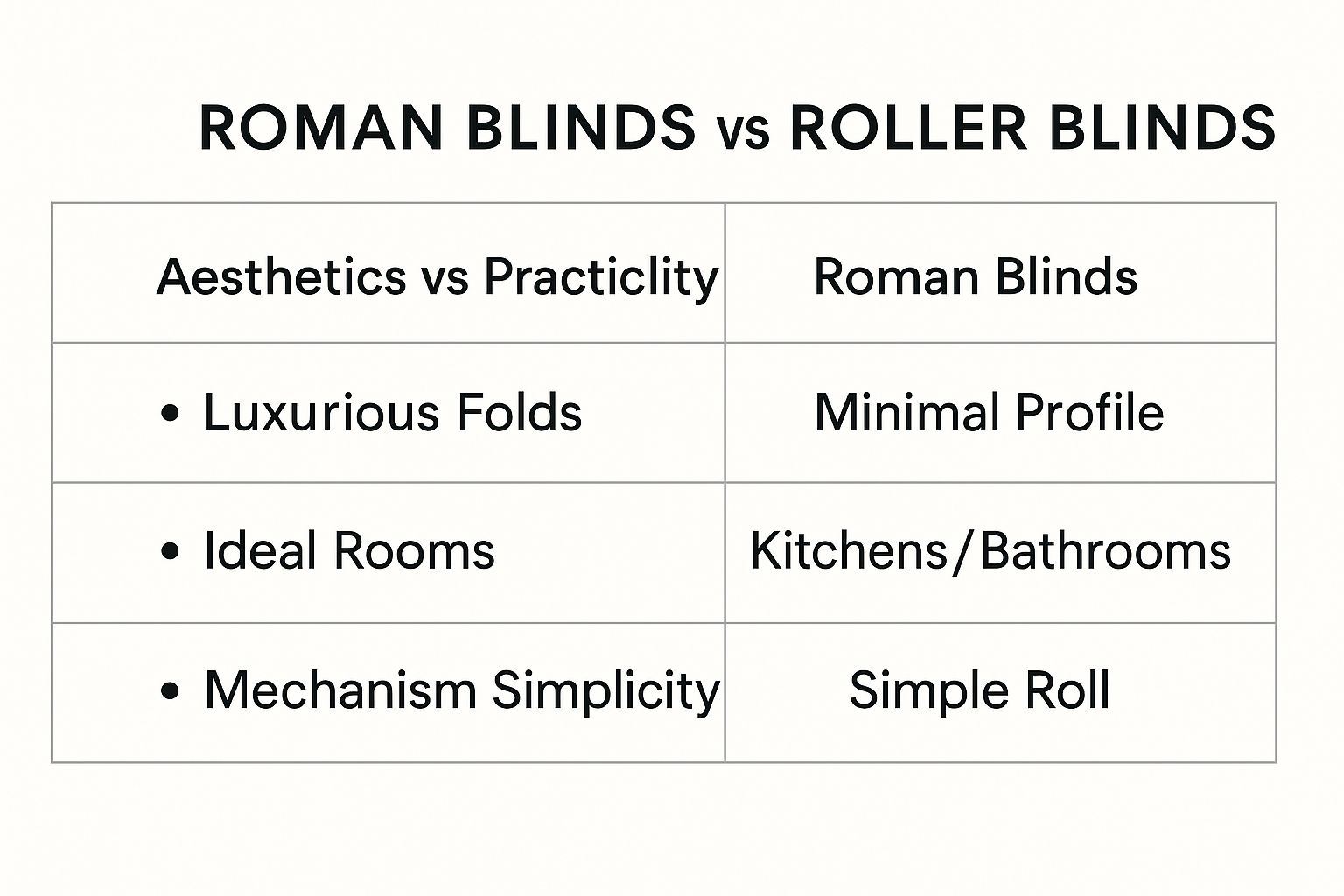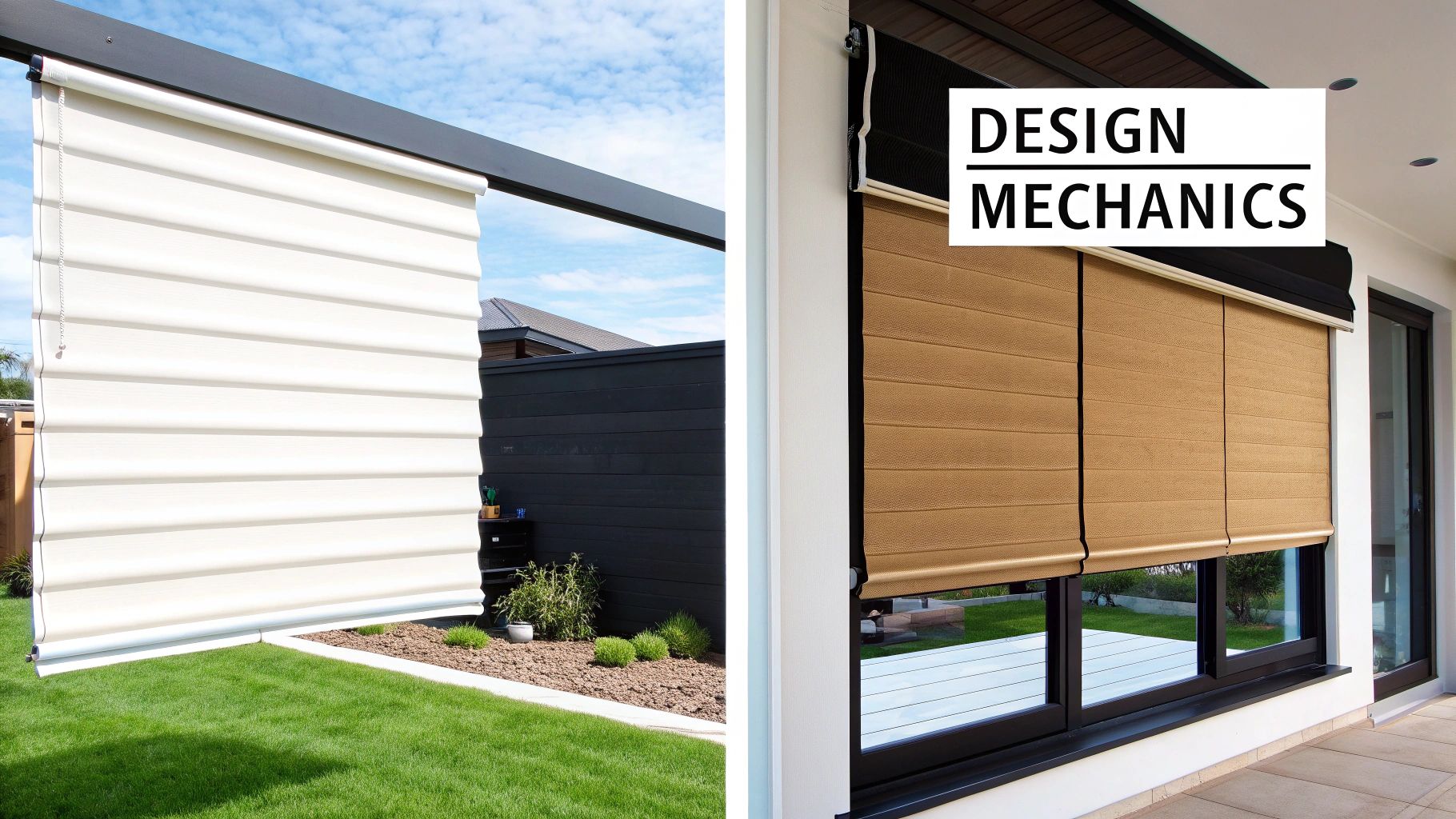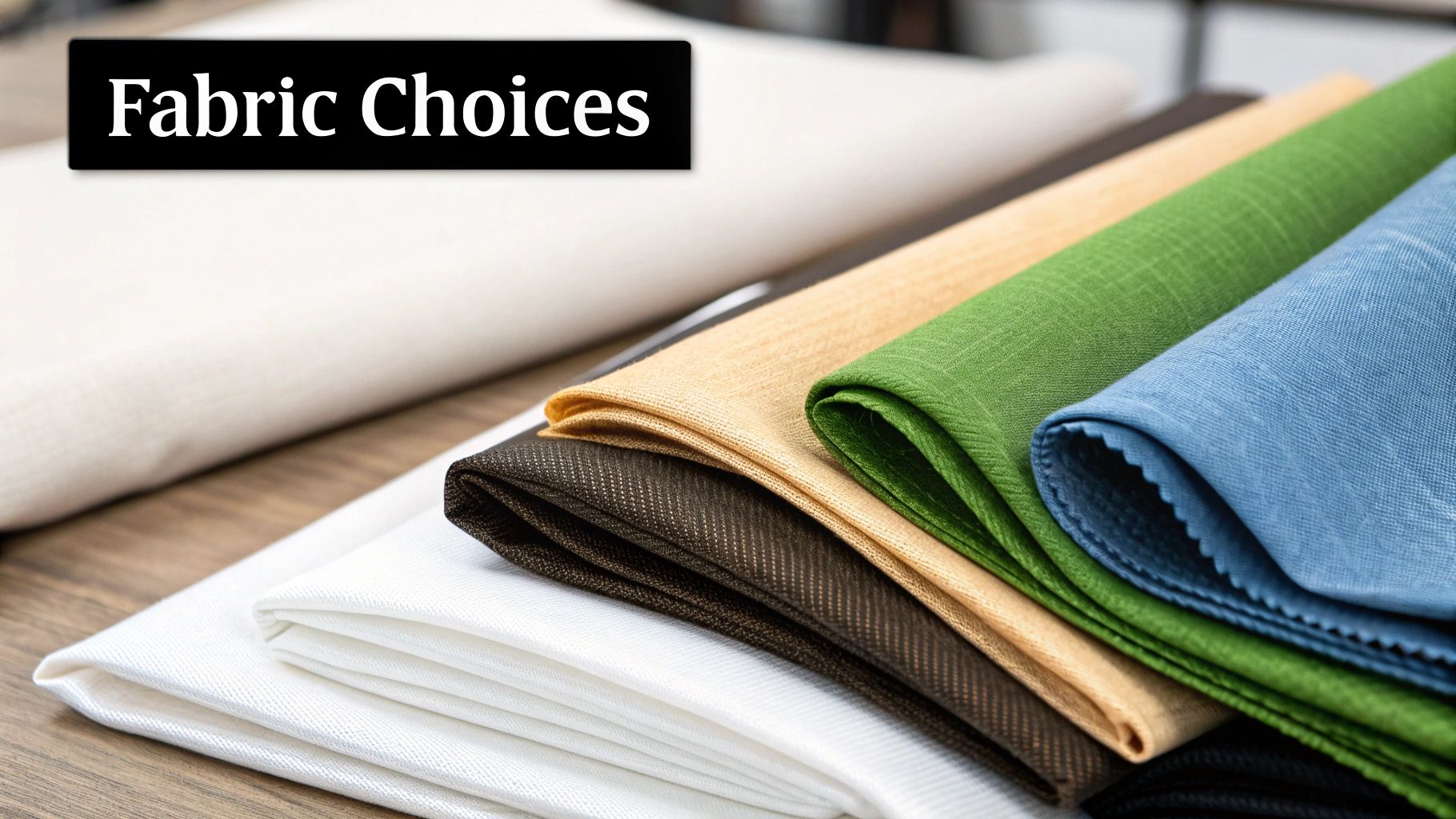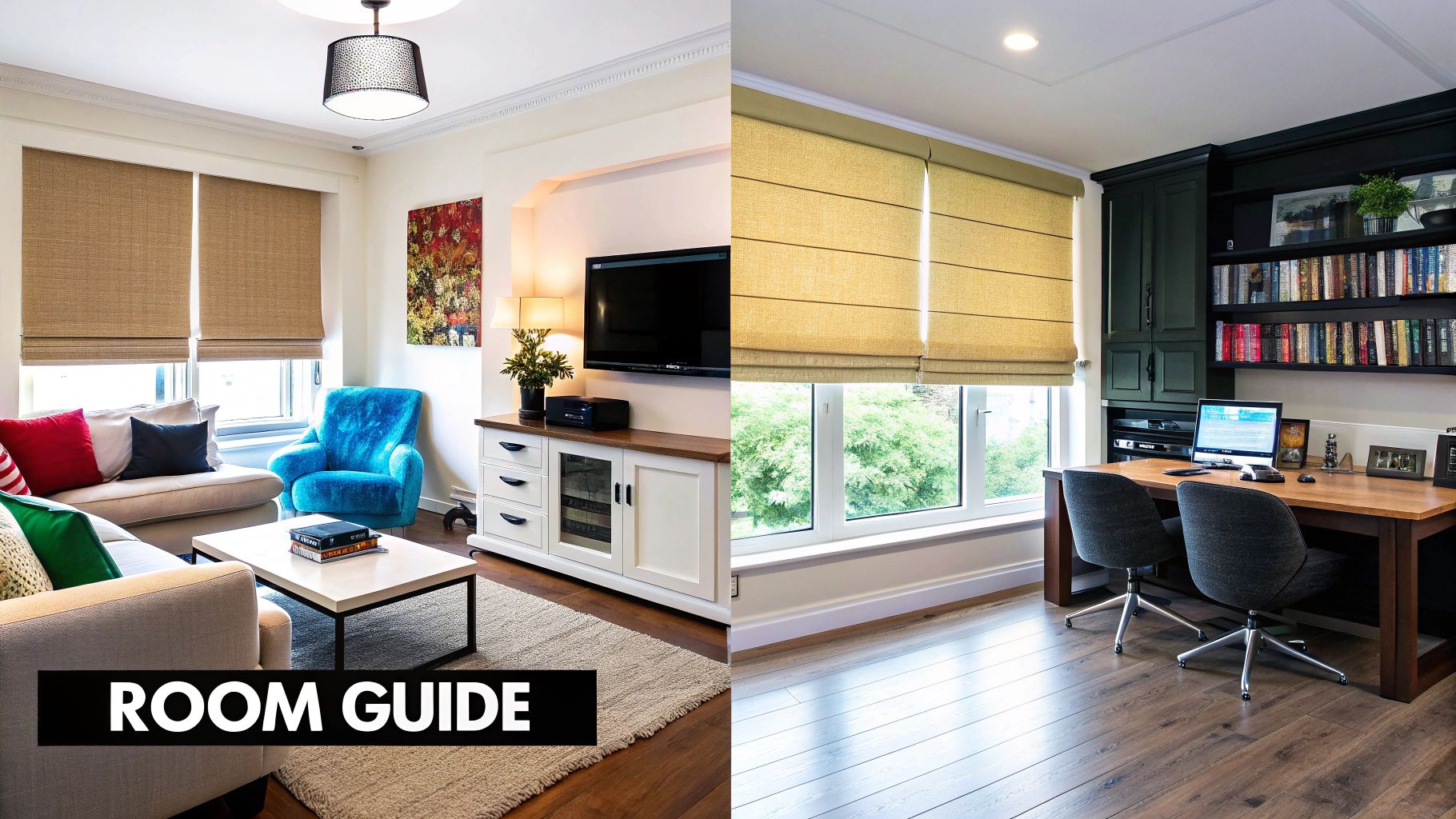Roman Blinds vs Roller Blinds Which Should You Choose
- Blindsmart im
- Oct 13
- 13 min read
Choosing between Roman and roller blinds often comes down to a classic dilemma: do you prioritise elegant aesthetics or streamlined practicality? It's a question of heart versus head. Roman blinds bring a soft, luxurious feel with their cascading fabric folds, making them a natural fit for living rooms and bedrooms where style and comfort are paramount.
On the other hand, roller blinds offer a sleek, minimalist function that feels right at home in modern kitchens, bathrooms, and home offices. In these spaces, clean lines, durability, and straightforward operation are usually the top priorities.
Roman vs Roller Blinds a Quick Comparison
Getting to grips with the fundamental differences between these two popular window treatments is the first step to making the right choice for your space. While both do a great job of covering your windows, they go about it in completely different ways, from their visual impact and operation to the rooms they suit best. One brings textured warmth, the other delivers clean simplicity.
To help you see exactly what we mean, this quick visual summary lays out their core characteristics.

The infographic highlights that Roman blinds are all about decorative elegance, while roller blinds are defined by their functional, modern profile. For those who like to dig into the details, the table below breaks down the comparison even further.
Roman Blinds vs Roller Blinds at a Glance
This table provides a simple, side-by-side look at how Roman and roller blinds stack up across the most important factors.
Feature | Roman Blinds | Roller Blinds |
|---|---|---|
Primary Appeal | Decorative, luxurious aesthetic with soft fabric folds. | Minimalist, sleek design with a clean profile. |
Best For | Living rooms, dining rooms, and bedrooms. | Kitchens, bathrooms, offices, and high-traffic areas. |
Light Control | Offers a soft, diffused light; less precise blockage. | Excellent light control, especially with blackout fabrics. |
Maintenance | Requires gentle vacuuming or specialised cleaning. | Easy to wipe clean, highly durable materials. |
Cost | Generally more expensive due to complex construction. | More budget-friendly and cost-effective for large windows. |
Ultimately, this quick comparison makes it clear: if your goal is to add a touch of sophisticated, soft texture to a room, Roman blinds are an excellent choice. But if you need a no-fuss, durable, and highly practical solution, roller blinds are tough to beat.
Design and How They Work: A Tale of Two Styles
At first glance, Roman and roller blinds might seem similar—they’re both fabric window coverings. But the real story is in how they’re built and how they move. This isn't just a fussy technical detail; it’s what defines their entire look and feel, shaping the atmosphere of your room.

The core difference comes down to one thing: folds versus rolls. Each has a completely different way of handling fabric, light, and privacy.
The Elegant Fold of a Roman Blind
A Roman blind is made from a single, unbroken piece of fabric. Cords run through little rings stitched onto the back. When you pull the cord, the fabric is drawn upwards, gathering into a series of soft, horizontal pleats.
These pleats stack up neatly at the top of the window. It’s this cascading effect that gives Roman blinds their luxurious, almost curtain-like quality. Even when it's fully open, the stack of fabric creates a sort of pelmet, adding a touch of classic sophistication and texture to the window frame.
The way it operates is all about combining form with function. It's designed to look beautiful in motion and at rest.
Soft Stacking: The gentle folds bring a real sense of warmth and comfort. This makes them a fantastic choice for living rooms and bedrooms where you want to create a cosy, inviting space.
Visual Interest: The pleats catch the light beautifully, adding a subtle texture and dimension that a completely flat surface just can't match.
Timeless Appeal: There’s a classic feel to this mechanism that works just as well in a traditional country cottage as it does in a modern-classic townhouse.
The deliberate, soft folding of a Roman blind introduces a structural elegance that transforms the window itself. It’s a design choice that says comfort and style are just as important as pure function.
The Clean Lines of a Roller Blind
Now, let's look at the roller blind. It's the champion of minimalist efficiency. The design is stripped back to its core elements: a flat sheet of fabric that wraps cleanly around a slim tube, usually made of aluminium or steel.
The whole thing is operated with a simple side chain, a spring mechanism, or a motor. The fabric glides down smoothly to cover the glass and then rolls back up to practically disappear, leaving you with a completely clear view. This simplicity is its biggest selling point, giving it a crisp, contemporary feel.
If you’re looking for even more flexibility, options like double roller blinds offer two fabrics on one bracket. But even the standard design is perfect for modern homes where clean lines and uncluttered spaces are the goal.
How Fabric Choices Define Style and Function
The material you choose for your blinds is about so much more than just style; it’s the very heart of how they perform. When it comes to Roman blinds vs roller blinds, the fabric dictates everything from the room's atmosphere to how well you can control light and even your energy bills. The right material can transform a simple window covering into a real standout feature.

Each type of blind really comes into its own with a different range of textiles, each one suited to its unique construction and purpose.
The Luxurious Textiles of Roman Blinds
Roman blinds are practically designed to show off fabric, turning beautiful textiles into a focal point. Their construction means you can use softer, more decorative materials—the kind you’d normally find on high-end sofas or curtains. It's all about adding texture, warmth, and a sense of depth to your space.
Some of the key fabric options include:
Cotton and Linen: These natural fibres give off a relaxed, classic look. They drape beautifully and come in endless colours and patterns, making them incredibly versatile for living rooms and bedrooms.
Velvet and Silk: For a truly opulent and formal feel, nothing beats these materials. Their rich texture and subtle sheen add a layer of sophistication that’s perfect for dining rooms or master suites.
Wools and Blends: Heavier fabrics like wool blends are fantastic for insulation. Their sheer weight helps trap heat, making them a smart, energy-efficient choice for draughty windows.
The weight of the fabric is crucial for creating those crisp, uniform folds that are the signature of a Roman blind. Lighter materials create a soft, casual stack when raised, whereas heavier ones give a much more structured, formal look.
The essence of a Roman blind lies in its fabric. Choosing the material is a deliberate move to create a cosy, insulated, and visually rich environment, where feel and aesthetic appeal are the priority.
High-Performance Fabrics for Roller Blinds
Roller blinds, on the other hand, are all about practicality and performance. Their fabrics are typically engineered to be durable, functional, and easy to look after, which perfectly matches their sleek, minimalist design. Here, the focus is less on touch and texture and more on specific functional properties.
In the UK, the sheer adaptability of roller blinds has cemented their popularity. While Roman blinds are often the go-to for their aesthetic depth in premium interiors, roller blinds have a larger market share because they’re just so functionally versatile. The broader European window blinds market, valued at USD 5.6 billion, clearly shows a trend towards practical, high-performance solutions like those offered by roller blinds. You can explore more about these market dynamics to see how consumer needs shape what’s popular.
Common materials for roller blinds include:
Polyester: A highly durable and versatile choice that resists shrinking and stretching. It's available in a huge range of colours and is dead easy to clean.
PVC and Vinyl: These materials are 100% waterproof, making them the perfect solution for steamy environments like kitchens and bathrooms. A quick wipe is all it takes to clean them.
Blackout Fabrics: These are engineered with a special backing to block all incoming light, making them essential for bedrooms, home cinemas, or any room that needs total darkness.
Thermal Fabrics: Featuring a reflective coating on the back, these fabrics help regulate room temperature. They reflect heat, keeping rooms cooler in summer and warmer in winter.
Analysing Light Control and Energy Efficiency
When you’re weighing up Roman blinds vs roller blinds, it’s about more than just how they look. Your choice will shape your room's atmosphere, your level of privacy, and even your energy bills. Both styles have their strengths when it comes to managing light and keeping your home comfortable, but they go about it in very different ways.
The real difference is how they handle sunlight. Roman blinds, with their soft, layered fabric, tend to diffuse light. They create a warm, gentle glow instead of total darkness, which is perfect for living rooms or dining areas where you want to cut the glare but keep the space feeling bright and welcoming.
Roller blinds, on the other hand, offer a much more straightforward approach to light control. Because they’re made of a single, flat piece of fabric, they give you clean, even coverage. When fitted well inside the window frame, they let very little light seep around the edges.
Mastering Light and Privacy
How much control you get really comes down to the fabric you choose. You could have a sheer roller blind that filters out the harshest UV rays while keeping your view, or you could go for a full blackout fabric. These are specifically designed to block all light, making them the obvious choice for bedrooms and media rooms.
Roman blinds offer a different kind of flexibility. The fabric itself becomes part of the room's character.
Light-filtering Linens: These are fantastic for creating a soft, airy feel. They give you privacy without sacrificing that lovely, gentle daylight.
Thick, Lined Fabrics: If you opt for heavier materials like wool or velvet with a blackout lining, you can dramatically darken a room and boost privacy.
For absolute, pin-sharp darkness, nothing beats a blackout roller blind. But if you're after a softer, cosier atmosphere with gentle light and better insulation, a well-lined Roman blind is the undisputed winner.
This decision often mirrors wider trends we're seeing in home improvement. People are more focused on energy efficiency than ever, and that's driving demand for high-performing window coverings. The UK blinds market, valued at USD 901.3 million, is expected to grow significantly, partly because of this push for eco-conscious home solutions. While roller blinds are incredibly adaptable, the premium feel and insulating properties of Roman blinds give them a solid place in the market.
The Impact on Thermal Performance
This is where the two styles really start to show their differences. The layered design of a Roman blind naturally creates pockets of trapped air, which act as an excellent insulator. When you make them with thick fabrics and add a thermal lining, they become brilliant at stopping heat from escaping in the winter and keeping rooms cool in the summer.
Roller blinds can also be great insulators, but you have to choose a specialised thermal fabric. These materials have a reflective coating on the back that literally bounces heat away from the window. Without that specific feature, a standard roller blind won’t offer much in the way of insulation. If you want to get into the nitty-gritty of how different materials can help you save on energy, our **homeowner's guide to insulated window blinds** has all the details.
At the end of the day, a well-made Roman blind generally offers better insulation right out of the box simply because of how it’s constructed. A thermal roller blind, however, can provide targeted, high-performance efficiency in a much sleeker, more minimalist design.
Installation, Upkeep, and Durability: The Practical Side
Looks are one thing, but how blinds fit into your everyday life is just as important. When you're weighing up Roman versus roller blinds, the practical stuff—like installation, cleaning, and how they hold up over time—can often be the deciding factor. It’s these day-to-day realities that determine whether a blind is a perfect match or a long-term frustration.
Getting Them on the Wall
One of the biggest practical differences is just how easy they are to put up. Roller blinds are famous for their simple setup, and you can often get them installed yourself in no time. The design is brilliantly straightforward: usually just two brackets holding a tube, which you can fit with a few basic tools.
Roman blinds, on the other hand, can be a bit more fiddly. Getting them perfectly level is non-negotiable, otherwise, the fabric won't stack up into those neat, even folds when you raise it. Even a slight misalignment can make the pleats look crooked and unprofessional, so you need a bit more patience and precision during installation.
Keeping Your Blinds Looking Fresh
The cleaning routine for each style is worlds apart. The sleek, flat panel of a roller blind makes it incredibly simple to look after.
Roller Blinds: Most materials, especially PVC and vinyl, just need a quick wipe with a damp cloth. This makes them a life-saver in kitchens or kids' rooms where splashes and sticky fingers are a fact of life.
Roman Blinds: Those lovely soft folds are magnets for dust. A regular, gentle once-over with your vacuum’s brush attachment is usually needed to keep them looking pristine.
When it comes to a deep clean, the luxurious fabrics on Roman blinds might need a professional touch to avoid any damage. A roller blind’s tough material is far more forgiving and can handle a more robust clean.
The real difference in upkeep comes down to this: roller blinds are built for quick, practical cleaning, whereas Roman blinds demand more delicate, regular care to preserve their elegant finish.
How Well Will They Last?
Finally, think about how each blind will stand the test of time. A roller blind has a very simple, tough mechanism—it's just a single sheet of fabric wrapping around a tube. With so few moving parts, there’s not much that can go wrong. This inherent simplicity makes them exceptionally durable, especially in busy rooms where they’re opened and closed constantly.
Roman blinds are more complex, with their network of cords, rings, and rods all working together. A good quality one is certainly built to last, but the cording system is naturally more prone to wear and tear over many years of use compared to the direct, fuss-free mechanism of a roller.
Making the Right Choice for Every Room
Deciding between Roman blinds and roller blinds isn’t about which one is universally better, but which is the perfect fit for a particular room. The right blind does more than just cover a window; it can completely transform a space by marrying style with pure practicality.
This room-by-room guide is designed to help you match the unique character of each blind to the way you use every area in your home, turning a tough decision into a confident choice.

Living Rooms and Bedrooms: Creating a Cosy Retreat
When it comes to spaces designed for relaxation, like your living room or master bedroom, Roman blinds are hard to beat. Their soft, cascading folds introduce a layer of texture and warmth that a simple roller blind just can't match. With a huge range of luxurious fabrics available—from plush velvets to timeless linens—you can easily cultivate a cosy, high-end atmosphere.
Beyond looks, the layered fabric construction gives them excellent thermal insulation properties, helping keep these rooms snug in the winter and comfortably cool in the summer. This blend of visual appeal and practical insulation makes them an ideal choice for creating an inviting sanctuary.
In rooms where atmosphere is everything, the decorative feel and insulating qualities of a Roman blind deliver an instant sense of luxury and comfort, making it the superior choice for bedrooms and lounges.
Kitchens and Bathrooms: Prioritising Practicality
In high-humidity, high-traffic zones like kitchens and bathrooms, practicality is king. This is where the simple, no-fuss design of a roller blind really comes into its own. Often made from materials like durable polyester or even 100% waterproof PVC, they are incredibly easy to look after. A quick wipe is usually all it takes to deal with splashes, steam, or cooking grime.
Their sleek, minimalist profile also takes up very little space, which is a real bonus in smaller bathrooms or utility rooms. They roll up tightly out of the way, leaving windowsills completely clear. For these hardworking spaces, the low-maintenance and moisture-resistant nature of a roller blind makes it the undisputed practical winner.
Home Offices: Balancing Focus and Style
A home office needs to be both a productive and a pleasant place to be, which presents a unique challenge. The best choice here often boils down to your main priority. If your biggest battle is with screen glare, a blackout roller blind is the perfect fix. It gives you precise light control and can plunge the room into darkness when you really need to focus.
On the other hand, if you want your workspace to feel less sterile and more in tune with your home's style, a Roman blind is an excellent option. It helps soften the room's acoustics and adds a decorative element that can make your office feel more refined and welcoming.
To get the best of both worlds, you could explore **custom blinds**. This lets you pick specific light-filtering fabrics that cut down on glare while still looking fantastic, ensuring your home office is a space where you can be both productive and comfortable.
Your Questions Answered
Choosing between Roman and roller blinds often comes down to a few key questions. I've heard the same queries from countless homeowners over the years, usually revolving around price, motorisation options, and how they fit unique window shapes. Let's clear up these final details so you can make a confident choice.
Cost is almost always the first thing people ask about. Put simply, roller blinds are generally the more wallet-friendly choice. Their straightforward design and use of modern, efficient fabrics keep the price down. Roman blinds, on the other hand, involve more intricate construction and often feature premium textiles like linen, velvet, or embroidered fabrics, which naturally places them at a higher price point.
Can Both Blind Types Be Motorised?
Absolutely. Both Roman and roller blinds are excellent candidates for motorisation. It’s a fantastic touch of modern convenience, letting you adjust your blinds with a remote or even connecting them to your smart home setup.
With a roller blind, the motor is tucked away neatly inside the roll itself, so it’s completely invisible. For a Roman blind, the motor system needs to be a bit more powerful to manage the weight and the stacking of the fabric folds, but the operation is just as smooth and discreet.
Thinking about motorisation? Consider your windows. For those high, hard-to-reach spots, like in a stairwell or a vaulted ceiling, a motorised system isn't just a nice-to-have; it's a game-changer for daily use.
Which Is Better for Bay Windows?
When it comes to bay windows, my recommendation is almost always Roman blinds. They just have the edge here. Because each blind is made to measure, they can be fitted perfectly into the individual frames of the bay, creating a truly seamless, tailored finish. The soft fabric folds also add a touch of warmth and depth that really enhances the architectural beauty of a bay.
You can use roller blinds, of course, but you'll almost always see noticeable gaps between each blind where the brackets sit. This can break up the clean, panoramic view that makes a bay window so special in the first place.
Ready to find the perfect fit for your home? The team at Blindsmart is here to help you explore stunning made-to-measure options on the Isle of Man. Visit our showroom or get in touch today
Article created using [Outrank](https://outrank.so)

Comments